I just got my new Kriegsspiel pieces in the mail. My own Christmas present to myself! Is that what most wargamers do?
They look great. I’m very excited. I got the measuring ‘apparatus’ too. I immediately set them up on the maps. Next, I had to put them on the Pub Battles maps. They looked great there too. I couldn’t help but wonder how they compared to Pub Battles.
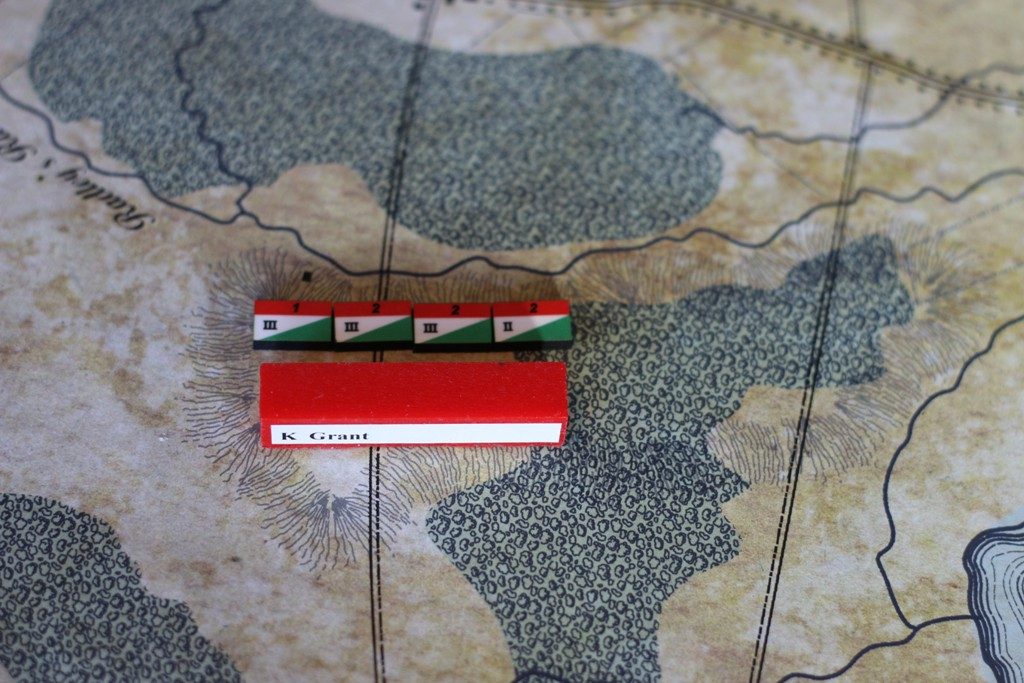
This is two Kriegsspiel Battalions in line formation, all spread out, end to end. Each small Kriegsspiel block is a ‘Half Battalion’ that represents 450 men. They almost equal the length of a Pub Battles Brigade at Brandywine.
Amazing how close these line up together but the scale is completely off. Two Battalions is what? One small Regiment? Nowhere near a Brigade. True but lets compare the actual numbers.
If each Kriegsspiel piece is 450 men, then these four blocks represent 1,800. How many men are in a Brigade at Brandywine? About 2,000. So actually, they match almost perfectly.
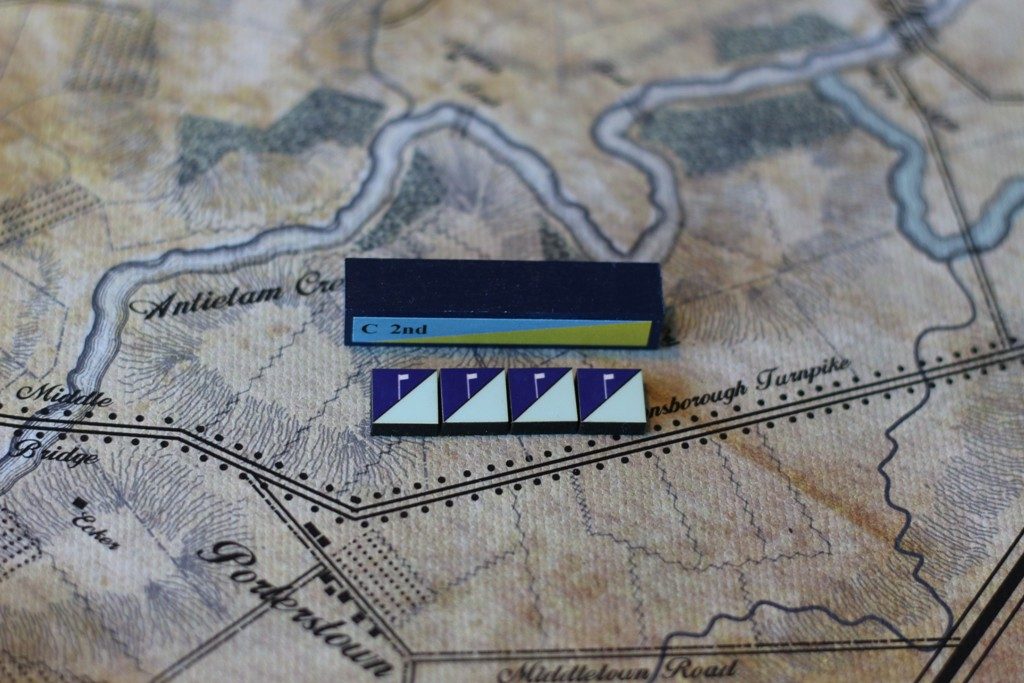
Here is a Union Cavalry Brigade at Sharpsburg with it’s Kriegsspiel equivalent.
The map scale is the same at Sharpsburg and Brandywine. The pieces are exactly the same size but they represent bigger formations. At Brandywine, a piece represents a 2,000 man Brigade. At Sharpsburg, each piece is a Division. Divisions are typically made up of 2-3 Brigades. These Brigades are about the same size: 1,500-2,000 men.
Here Sykes’ Division prepares to attack DH Hill in the Sunken Road in Pub Battles:


Ok, now how would this look if we set it up in Kriegsspiel blocks? Like this:
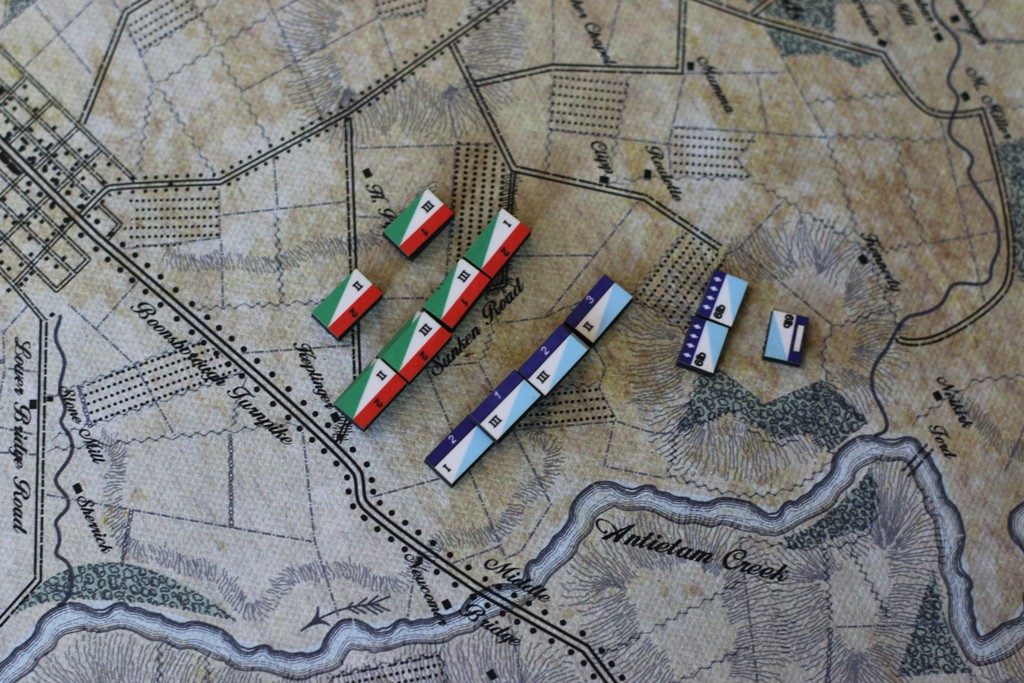
What?! How can that be the same? If the map scales are the same, how could a whole Division fit in the same space as a Brigade? Because in Kriegsspiel, the blocks stack. Here are the same pieces shown at an angle:
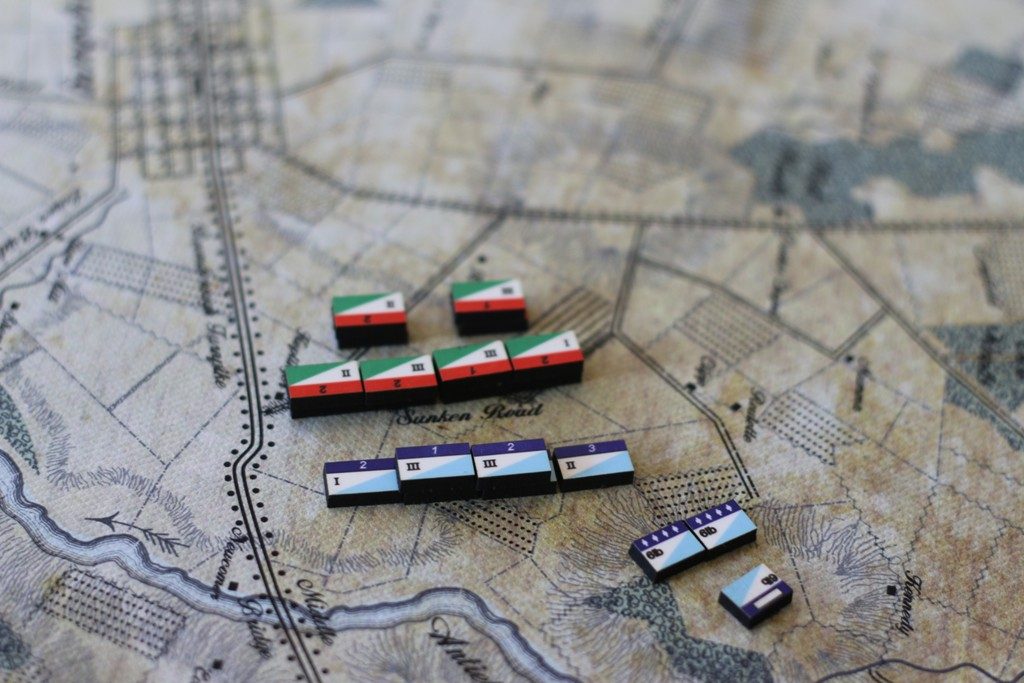
This was a different war. Greater numbers were involved. The concentration of troops was higher. There you go. The Kriegsspiel pieces can stack up to 4 high. They are extremely versatile.
I think terminology here is causing the confusion. Basically, what Kriegsspiel calls a Battalion is really a Regiment in the Civil War of 1,000 men. Two Regiments lined up end to end is a Brigade. Stack another 1-2 Regiments on top and you have a Division.
Another fascinating thing about the Kriegsspiel blocks is how they accommodate road column marches.
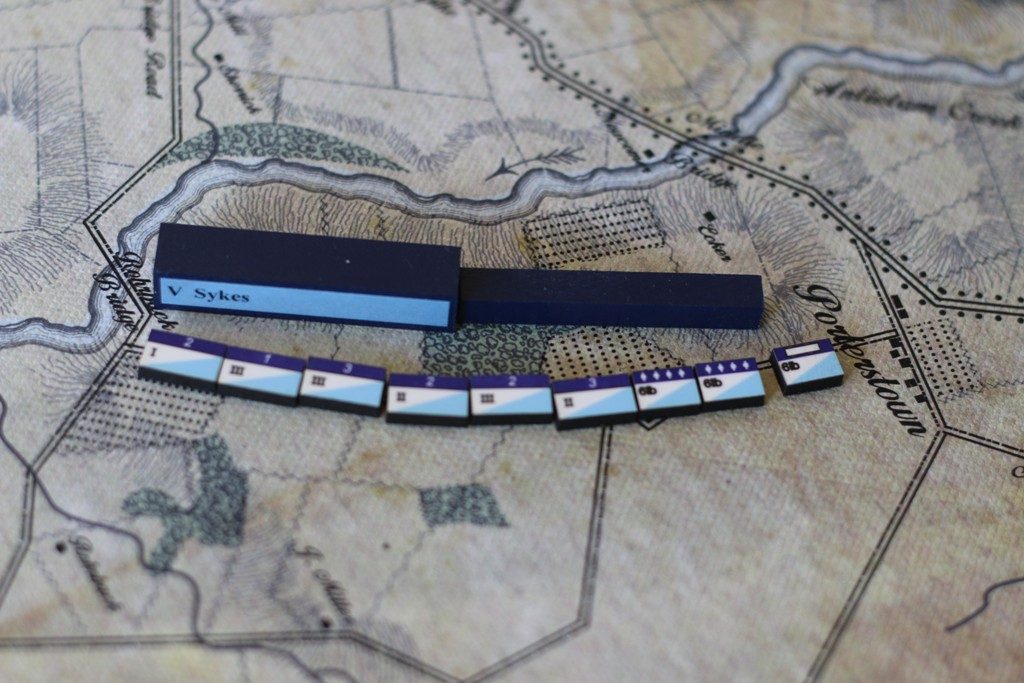
This is Sykes’ Division all strung out along the road. I have a couple of artillery batteries tagging along also. These cover about the same ground as a HQ and a few support pieces. As you can see, it is very close to the Pub Battles block with a trailing road column piece.
Another interesting thing you can do with the Kriegsspiel blocks is: Line Extension. In a pinch, you could spread out to cover more ground. It is going to be a fragile line though.
So far, everything appears to be sync-ing up. You could easily use Kriegsspiel blocks to play a Pub Battles game. This could give you more detail and precision. There is one key difference: map scale.
The map scale is off by about 2:1. So the official Kriegsspiel map is ‘zoomed in’ nearly twice as much compared to a Pub Battles map.
Strange. How could that be? Everything was matching up perfectly. I’ve been checking historical maps. The Pub Battles scale does match actual troop deployments for the real battles. Does that mean Kriegsspiel is wrong?
No. I think Kriegsspiel has it right. They are just looking at a smaller scale. So our Division at Sharpsburg does fit in this space. Note how it is all stacked up in a concentrated line. In Kriegsspiel, it would actually be spread out more with space between the blocks. This is a ‘Division’ setup in Kriegsspiel scale:
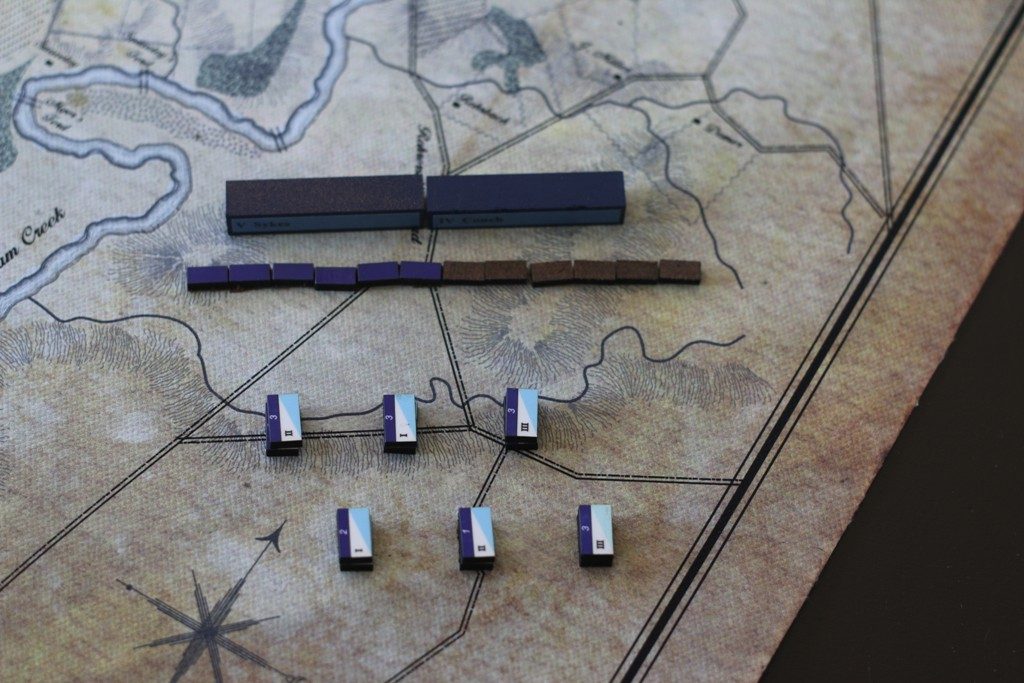
First you would have your skirmish line out front. The ‘Regiments’ are in attack column 300 paces behind. They are not all stacked up together. They are spread out with about 200 paces space between them. Three other Regiments follow on behind but staggered.
Remember, we are ‘zoomed in’ now about 2:1. So I’ve put 2 Pub Battles blocks to compare. Sure enough, this formation is about the width of 2 Pub Battles blocks.
So basically, at Pub Battles scale, we have zoomed out so we can fit the entire battle on a reasonably sized map. We fit the same troops in half the space by getting rid of all this extra space in formations. The down side is that you lose the detail of skirmishers and various formation options.
Could you use Pub Battles maps to play Kriegsspiel on? Absolutely. They are ideal if you want to fight out an entire battle at once. You would just need to remember that your distances are 2:1.
Here is another question: Could you use Kriegsspiel blocks to play Pub Battles with? Yes! This can easily add a lot more detail and precision to the game. Just keep in mind that this will also add time to the game as well.

Re the ACW units, I would note that during most of their wartime service, few regiments ever put 1,000 men on the field, it was usually more like 400-600 for the Union (the entire Irish Brigade at Gettysburg was about 1,000 men from 5 regiments).
Yes, nominally 400-1,000 men per regiment. 3-5 regiments per Brigade with a total of 1,000 to 2,500 men. Lots of variance.
How many men did the Irish Brigade start with at Antietam? I’m having trouble finding this number.
The Irish Brigade at Antietam: 29th Mass – 380, 63rd NY 341, 69th NY 317 (331 with officers), 88th NY 302 (28th Mass was not yet part of the Irish Brigade). Total = 1354
Numbers from The Maryland Campaign of September 1862: Ezra A. Carman’s Definitive Study
Also see Antietam on the web: http://antietam.aotw.org/officers.php?unit_id=436
Please clarify, the Pub Battles maps are twice as large as would be expected for Kreigspiel , or half the size?
If a Pub Battles map was to be true Kriegsspiel scale (1:8000), you would have to double the size of the Pub Battles map. It would be twice as large. So in effect, the Pub Battles maps are zoomed out to a larger scale.
Usually, Kriegsspiel engagements are much smaller in scale. Typically you will see scenario engagements between Brigades or maybe whole Divisions. You could theoretically fight an entire battle but you would need a map the size of a ping pong table, tons of pieces and a full staff working as Umpires to control and move everything.
By zooming out in scale, we can fit the whole battle on a reasonably sized map.
Be careful when using terms like “division,” “brigade” and “battalion” across different military periods. In game terms, the lowest building block for conventional infantry formations is about 350 to 600 men in the black powder era. This is a function of physical span of control limits for musket-bearing soldiers in linear formations, two- to four-ranks deep.
In the American Civil War, divisions were not linear formations. They were higher-level collections of individual, linearly deployed brigades, themselves of varying strength. Both Union and Confederate divisions typically deployed in two lines, with some brigades deployed abreast in a first line, and an additional group of brigades deployed behind them, in support. This is why the blocks in Antietam and Gettysburg are smaller than they would be if the brigades were all deployed in a single long line.
American Revolution formations are far more problematic. Rebel “regiments” were more administrative than tactical, few of them large enough to perform as a functional “battalion” on the British model. They routinely task organized on the battlefield, disregarding regimental affiliations, into battalion-size groups of 350 to 450 Continentals.